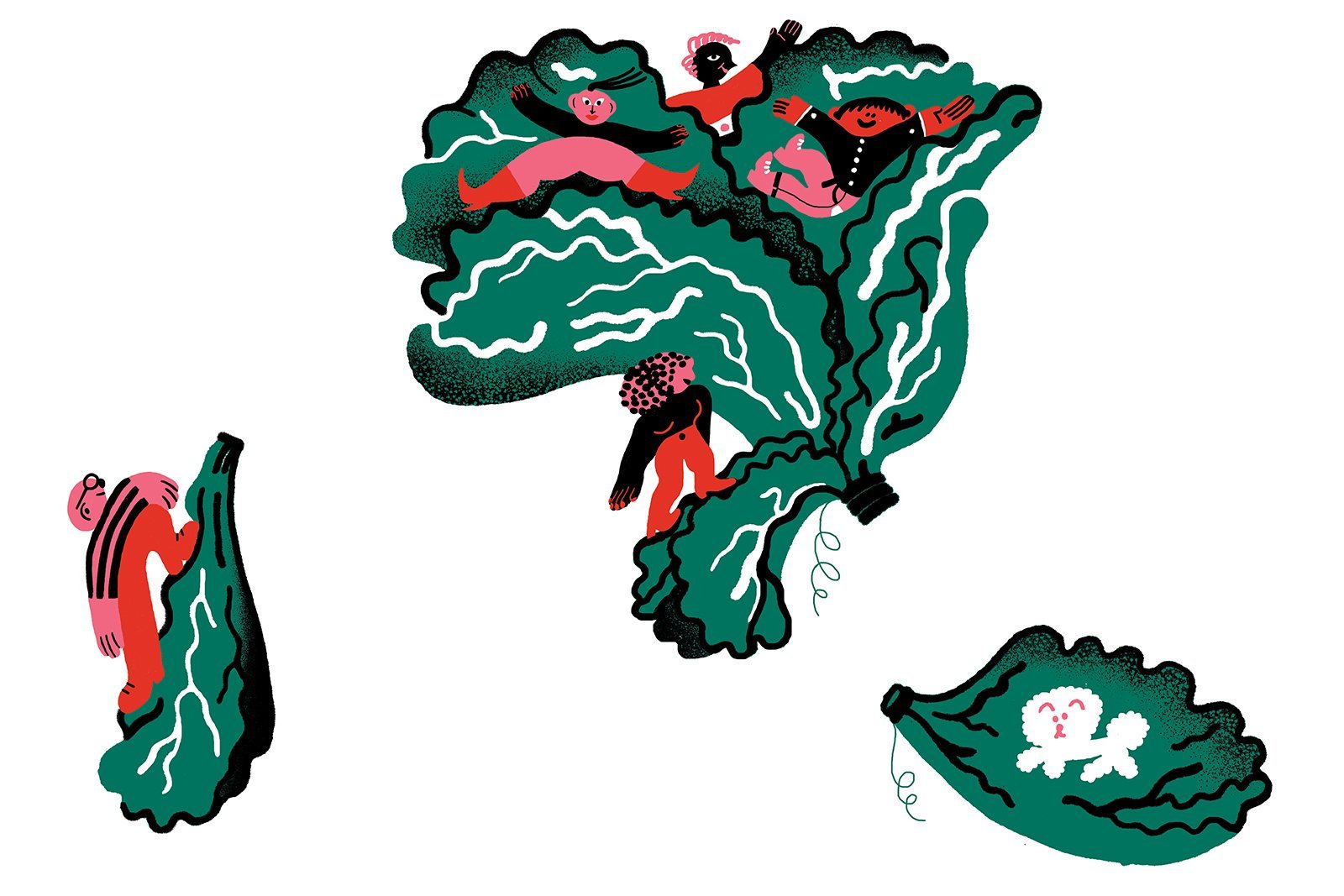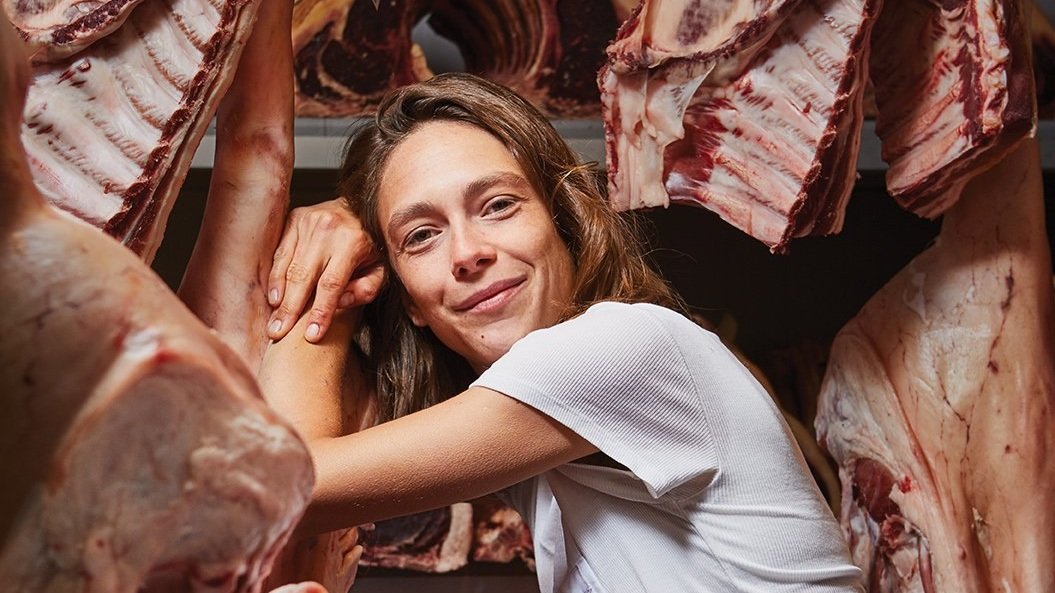A Swift Dispatch On The Future Of Lettuce
Text by Anna Sulan Masing
Illustrations by Sarah Mazzetti
On 8 May 2014 a crop of red romaine lettuce (Outredgeous) flew in space as the first veggie unit of NASAVeg-01A. This was the beginning of a project to grow vegetables in space. But why lettuce? Why space?!
In a time-old tradition, satisfying humanity’s need to travel—explore, migrate, conquer, colonize, escape to lands unknown—we are now looking to the stars for our future endeavor. As sailors and scurvy taught us, fresh fruit and veg are absolutely vital to survive long trips. In order to get to Mars and beyond, we need to be able to grow edible things on space ships. It’s that simple.
Trent Smith is a plant researcher at Kennedy Space Center in Florida. He explains that the choice of lettuce for the Veg-01A mission was a practical one: “It is compact, grows fast, is robust, it germinates reliably, it has high amounts of antioxidant, which gives it the red pigment, and it tastes good.” The project is currently on iteration Veg-04B, whose aim it is to see how Mizuna ‘Japanese mustard greens’ grow under red-rich light treatment and blue-rich light treatment for 56 days—the longest time-frame for any such experiment thus far. Whatever is harvested, half is eaten by the crew and the other half is kept for analysis.
But it’s not just farming science as Veg-04 looks further than just the practical. “We are aiming to quantify the taste profile of the plants grown under different light treatments as well as how growing and eating the plants impacts the crew in their daily lives,” Smith explains. “Taste is very important. If something doesn’t taste good, it is unlikely to be eaten. This is true at my house, this is true in the field with the military, and true on the ISS. Flavorful, fresh, nutritious crops are the goal.” With relief, our future selves won’t be roaming deep space with a ‘food for substance’ attitude.
So lettuce and its kin are center stage of current space exploration, but in the West—on Earth—we have relegated our leafy friends to a side dish, or a starter salad. It hasn’t always been this way, and other cultures do celebrate the lettuce in the glory it deserves.
Lettuce was first cultivated in Ancient Egypt and it was the romaine lettuce, again, that was leading the way into the future for the plant. Lettuce was sacred to the Ancient Egyptians and became a symbol for Min the god of fertility, with murals painted of large erect, romaine-esque lettuces. In the magazine Smithsonian, Professor Salima Ikram explains, “it grows straight and tall—an obvious phallic symbol. But if you broke off a leaf it oozed a sort of white-ish, milky substance—basically it looked like semen.” Antiquity was hot for lettuce.
“Lettuce and its kin are center stage of current space exploration.”
From Egypt it moved west via the Greeks and Romans, and then with Christopher Columbus’ colonial conquering, to the Americas. Lettuce migrated east through to China, where it has maintained a valued position in culture. Georgine Leung, food culturalist and nutritionist based in Hong Kong and London says, “lettuce is called ‘sang choi’ in Chinese. The first character means life or growth, while the second character resonates with ‘fortune’. It is always eaten for good luck because of the social meaning it carries when eaten together at family celebrations such as Chinese New Year.”
And of course, lettuce is good for you. “While not as nutritionally dense as other vegetables, it still counts as [one of] your five a day,” says Rhiannon Lambert, a leading London-based nutritionist. “100 grams of Romaine lettuce actually meets your daily value for vitamin A and K, and offers 40 percent of your vitamin C intake. And the good thing with leafy greens like lettuce is they tend to be eaten with other vegetables, helping to ‘balance’ the vitamins and minerals of a meal.” Lambert suggests that spinach, kale, tomatoes and broccoli would be great to see grown beside the lettuce, in developing a homegrown healthy diet.
So where does that place our leafy greens in today’s future? Is its role to simply boldly go where no plant has gone before?
In 2016 NASA awarded a grant to US company Freight Farms, to work alongside South Carolina’s Clemson University, in researching ways of growing food in extreme climates. The aim was to create a system that would run independently from the energy grid with renewable energy sources and water reclamation methods. Freight Farms’ COO and co-founder, Jon Friedman, explains that, “In conjunction with developed processes to harvest seed-producing plants and recycle biomass, it could eventually sustain life with zero input required.” Innovation like this not only serves deep space exploration, but also earthly situations—from disaster relief to off-shore industries, and remote living in difficult climates.
Trent described the relationship between NASA research and controlled environment agriculture, such as Freight Farms and other hydroponic systems, as linked: “Having a more sustainable plant growth system is the long-term goal. Any breakthroughs we make are of interest to them [controlled environment agriculture] and of course, their breakthroughs could help feed future astronauts.”
The Freight Farm x Clemson University project informed innovation around water consumption to less than 95 percent of traditional agriculture—supporting 13,000 plants with approximately five gallons of water a day—“less than the average dishwasher”—red and blue LED lighting, airflow and thermal capacity so it can maintain an average of 70 ̊F in extreme climates.
Sebastian Sainsbury is the founder of a UK-based vertical hydroponic farming system called Crate to Plate, and he brings thing back down to Earth: “2018 was the hottest, longest heatwave in 40 years in the UK, and British farmers—who typically supply us with 90 percent of produce, lost their crops over a two-month period. What NASA is doing is looking 50 to 100 years from now, and what interests me is the ability to grow locally and service the community. I have been lucky to be able to afford to buy organic, but most people can’t [and] current population growth statistics show organic farming is not sustainable [It’s possible to grow 18 GMO tomatoes for every one organic]. Vertical farming could address these [sustainability] issues.”
He further explains that their container farms can be adapted to be managed by one person, meaning that growing healthy, local produce can return to community spaces. NASA’s Jon Friedman also wants to see this technology accessed in a wider capacity, emphasizing the ease of it, so that, “students are taught the importance of sustainable agriculture, nutrition, and given access to technology that’s as advanced as it is approachable.” While expanding on this idea as an excellent community-connecting possibility, Georgine Leung offers pause for thought: “The idea supports the surge of smaller, local movements of urban farming and corresponds to renewed interest from people wanting to reconnect with the land and to cultivate ‘their own’. But, many city dwellers—at least in Asia—are not interested in doing the hard labor of work and growing their own, despite demand.”
The idealism behind controlled environment agriculture is grounded in huge potential, but there are also very real constraints. “Vertical farming is constrained due to the structure and weight of what you are growing. We can grow certain varieties of vine tomatoes, but because of the weight of a regular tomato, we are unable to grow more commonly known species,” Sainsbury explains.
In-space constraints include volume and weight, but also ‘opportunistic microbes’. Trent Smith reveals: “On ISS in 2015 our Zinnias [a North American flower] were stressed and a fungus took advantage. However, astronaut Scott Kelly was able to save two plants, which bloomed for weeks and he made the world’s first off-planet bouquet on Valentine’s Day 2016.” And astronauts have other duties besides tending flowers and lettuce, therefore robotic innovation is a focus.
But back to why lettuce and its leafy green friends are important in farming innovation, globally. “The Greenery [Freight Farm’s latest container system] supports leafy greens, herbs, edible flowers, root vegetables—think arugula, peppers, rosemary, flowers, chives, string beans, peapods, and radishes all growing side-by-side in one unit. But leafy greens have historically been the most popular vegetable because of efficiency—they grow faster than other crops, and can therefore be sold faster and more often,” Friedman explains.
And so, in the cyclical nature of farming, shall we return to the worshipping of lettuce, a plant that will ensure a fertile future? Looking to the far-flung horizon of food production, we know it needs to be efficient, accessible and healthy. It has to be grounded in ingredients that are usable and understood across various food cultures. As we navigate the stars—conceptually or, eventually, in reality—we have to also look back to earth, to balance health, innovation and science, with people, communities and culture.













